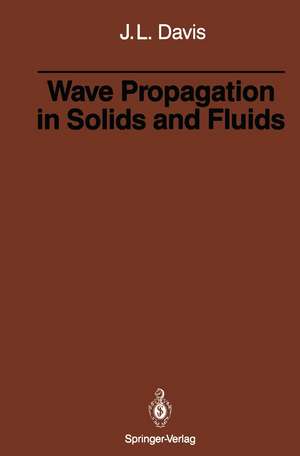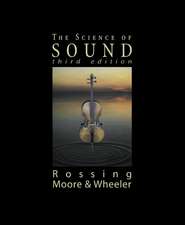Wave Propagation in Solids and Fluids
Autor Julian L. Davisen Limba Engleză Paperback – 23 sep 2011
Preț: 645.47 lei
Preț vechi: 759.37 lei
-15% Nou
Puncte Express: 968
Preț estimativ în valută:
123.51€ • 129.30$ • 102.20£
123.51€ • 129.30$ • 102.20£
Carte tipărită la comandă
Livrare economică 08-22 aprilie
Preluare comenzi: 021 569.72.76
Specificații
ISBN-13: 9781461283904
ISBN-10: 1461283906
Pagini: 400
Ilustrații: X, 386 p.
Dimensiuni: 155 x 235 x 21 mm
Greutate: 0.56 kg
Ediția:Softcover reprint of the original 1st ed. 1988
Editura: Springer
Colecția Springer
Locul publicării:New York, NY, United States
ISBN-10: 1461283906
Pagini: 400
Ilustrații: X, 386 p.
Dimensiuni: 155 x 235 x 21 mm
Greutate: 0.56 kg
Ediția:Softcover reprint of the original 1st ed. 1988
Editura: Springer
Colecția Springer
Locul publicării:New York, NY, United States
Public țintă
ResearchCuprins
1 Oscillatory Phenomena.- 1.1. Harmonic Motion.- 1.2. Forced Oscillations.- 1.3. Combination of Wave Forms.- 1.4. Oscillations in Two Dimensions.- 1.5. Coupled Oscillations.- 1.6. Lagrange’s Equations of Motion.- 1.7. Formulation of the Problem of Small Oscillations for Conservative Systems.- 1.8. The Eigenvalue Equation.- 1.9. Similarity Transformation and Normal Coordinates.- 2 The Physics of Wave Propagation.- 2.1. The Conservation Laws of Physics.- 2.2. The Nature of Wave Propagation.- 2.3. Discretization.- 2.4. Sinusoidal Wave Propagation.- 2.5. Derivation of the Wave Equation.- 2.6. The Superposition Principle, Interference Phenomena.- 2.7. Concluding Remarks.- 3 Partial Differential Equations of Wave Propagation.- 3.1. Wave Equation as an Equivalent First-Order System.- 3.2. Method of Characteristics for a Single First-Order Quasilinear Partial Differential Equation.- 3.3. Second-Order Quasilinear Partial Differential Equation.- 3.4. Method of Characteristics for Second-Order Partial Differential Equations.- 3.5. Propagation of Discontinuities.- 3.6. Canonical Form for Second-Order Partial Differential Equations with Constant Coefficients.- 3.7. Conservation Laws, Weak Solutions.- 3.8. Divergence Theorem, Adjoint Operator, Green’s Identity, Riemann’s Method.- 4 Transverse Vibrations of Strings.- 4.1. Solution of the Wave Equation, Characteristic Coordinates.- 4.2. D’Alembert’s Solution.- 4.3. Nonhomogeneous Wave Equation.- 4.4. Mixed Initial Value and Boundary Value Problem, Finite String.- 4.5. Finite or Lagrange Model for Vibrating String.- 5 Water Waves.- 5.1. Conservation Laws.- 5.2. Potential Flow.- 5.3. Two-Dimensional Flow, Complex Variables.- 5.4. The Drag Force Past a Body in Potential Flow.- 5.5. Energy Flux.- 5.6. Small Amplitude Gravity Waves.- 5.7. Boundary Conditions.- 5.8. Formulation of a Typical Surface Wave Problem.- 5.9. Simple Harmonic Oscillations in Water at Constant Depth.- 5.10. The Solitary Wave.- 5.11. Approximation Theories.- 6 Sound Waves.- 6.1. Linearization of the Conservation Laws.- 6.2. Plane Waves.- 6.3. Energy and Momentum.- 6.4. Reflection and Refraction of Sound Waves.- 6.5. Sound Wave Propagation in a Moving Medium.- 6.6. Spherical Sound Waves.- 6.7. Cylindrical Sound Waves.- 6.8. General Solution of the Wave Equation.- 6.9. Huyghen’s Principle.- 7 Fluid Dynamics.- I. Inviscid Fluids.- 7.1. One-Dimensional Compressible Inviscid Flow.- 7.2. Two-Dimensional Steady Flow.- 7.3. Shock Wave Phenomena.- II. Viscous Fluids.- 7.4. Viscosity, Elementary Considerations.- 7.5. Conservation Laws for a Viscous Fluid.- 7.6. Flow in a Pipe, Poiseuille Flow.- 7.7. Dimensional Considerations.- 7.8. Stokes’s Flow.- 7.9. Oscillatory Motion.- 7.10. Potential Flow.- 8 Wave Propagation in Elastic Media.- Historical Introduction to Wave Propagation.- 8.1. Fundamental Concepts of Elasticity.- 8.2. Equations of Motion for the Stress Components.- 8.3. Equations of Motion for the Displacement, Navier Equations.- 8.4. Propagation of a Plane Elastic Wave.- 8.5. Spherically Symmetric Waves.- 8.6. Reflection of Plane Waves at a Free Surface.- 8.7. Surface Waves, Rayleigh Waves.- 9 Variational Methods in Wave Phenomena.- 9.1. Principle of Least Time.- 9.2. One-Dimensional Treatment, Euler’s Equation.- 9.3. Euler’s Equations for the Two-Dimensional Case.- 9.4. Generalization to Functional with More Than One Dependent Variable.- 9.5. Hamilton’s Variational Principle.- 9.6. Lagrange’s Equations of Motion.- 9.7. Principle of Virtual Work.- 9.8. Transformation to Generalized Coordinates.- 9.9. Rayleigh’s Dissipation Function.- 9.10. Hamilton’s Equations of Motion.- 9.11. Cyclic Coordinates.- 9.12. Lagrange’s Equations of Motion for a Continuum.- 9.13. Hamilton’s Equations of Motion for a Continuum.- 9.14. Hamilton-Jacobi Theory.- 9.15. Characteristic Theory in Relation to Hamilton-Jacobi Theory.- 9.16. Principle of Least Action.- 9.17. Hamilton-Jacobi Theory and Wave Propagation.- 9.18. Application to Quantum Mechanics.-9.19. Asymptotic Phenomena.
















